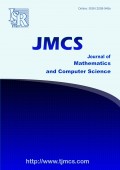Theoretical analysis of perturbation multi-dividing ontology learning algorithm
Authors
W. Gao
- School of Information Science and Technology, Yunnan Normal University, Kunming 650500, China.
J. Zhou
- Key Laboratory of Education Informatization for Nationalities, Ministry of Education, Yunnan Normal University, Kunming 650500, China.
Abstract
The multi-dividing ontology learning algorithm is specially designed for tree-structured ontology graphs, and has become a paradigm of graph-based ontology learning. In view of the disturbance of ontology data, this paper proposes perturbation multi-dividing ontology learning approach. Assuming that the perturbed ontology data are drawn from the same distribution as before, the error bound of perturbation multi-dividing ontology learning is given in such hypothesis. Finally, we analyze flaws in theoretical results and gaps with practical applications, and raise the open problem for future study.
Share and Cite
ISRP Style
W. Gao, J. Zhou, Theoretical analysis of perturbation multi-dividing ontology learning algorithm, Journal of Mathematics and Computer Science, 39 (2025), no. 3, 325--337
AMA Style
Gao W., Zhou J., Theoretical analysis of perturbation multi-dividing ontology learning algorithm. J Math Comput SCI-JM. (2025); 39(3):325--337
Chicago/Turabian Style
Gao, W., Zhou, J.. "Theoretical analysis of perturbation multi-dividing ontology learning algorithm." Journal of Mathematics and Computer Science, 39, no. 3 (2025): 325--337
Keywords
- Ontology
- similarity measuring
- perturbation multi-dividing ontology learning algorithm
MSC
References
-
[1]
W. Abbes, D. Sellami, S. Marc-Zwecker, C. Zanni-Merk, Fuzzy ontology for automatic skin lesion classification, J. Test. Eval., 49 (2021), 2994–3014
-
[2]
S. K. Anand, S. Kumar, Uncertainty analysis in ontology-based knowledge representation, New Gener. Comput., 40 (2022), 339–376
-
[3]
A. Assa, K. N. Plataniotis, Wasserstein-distance-based Gaussian mixture reduction, IEEE Signal Process. Lett., 25 (2018), 1465–1469
-
[4]
J. Boži´c, Ontology-based metamorphic testing for chatbots, Softw. Qual. J., 30 (2022), 227–251
-
[5]
L. Buoncompagni, S. Y. Kareem, F. Mastrogiovanni, Human activity recognition models in ontology networks, IEEE Trans. Cybern., 52 (2022), 5587–5606
-
[6]
T. Ö. Çelik, A. Jamneshan, G. Montúfar, B. Sturmfels, L. Venturello, Wasserstein distance to independence models, J. Symb. Comput., 104 (2021), 855–873
-
[7]
H.-B. Chen, J. Niles-Weed, Asymptotics of smoothed Wasserstein distances, Potential Anal., 56 (2022), 571–595
-
[8]
C. Dubslaff, P. Koopmann, A.-Y. Turhan, Enhancing probabilistic model checking with ontologies, Form. Asp. Comput., 33 (2021), 885–921
-
[9]
W. Gao, Y. Chen, Approximation analysis of ontology learning algorithm in linear combination setting, J. Cloud Comput.- Adv. S., 9 (2020), 10 pages
-
[10]
W. Gao, M. R. Farahani, Generalization bounds and uniform bounds for multi-dividing ontology algorithms with convex ontology loss function, Comput. J., 60 (2017), 1289–1299
-
[11]
W. Gao, J. L. G. Guirao, B. Basavanagoud, J. Wu, Partial multi-dividing ontology learning algorithm, Inform. Sci., 467 (2018), 35–58
-
[12]
W. Gao, Y. Zhang, J. L. G. Guirao, Y. Chen, A discrete dynamics approach to sparse calculation and applied in ontology science, J. Differ. Equ. Appl., 25 (2019), 1239–1254
-
[13]
J. Lu, J. Ma, X. Zheng, G. Wang, H. Li, D. Kiritsis, Design ontology supporting model-based systems engineering formalisms, IEEE Syst. J., 16 (2022), 5465–5476
-
[14]
I. Osman, S. B. Yahia, G. Diallo, Ontology integration: approaches and challenging issues, Inf. Fusion, 71 (2021), 38–63
-
[15]
V. M. Panaretos, Y. Zemel, Statistical aspects of Wasserstein distances, Annu. Rev. Stat. Appl., 6 (2019), 405–431
-
[16]
J. Shi, Y. Wang, Hyperbolic Wasserstein distance for shape indexing, IEEE Trans. Pattern Anal. Mach. Intell., 42 (2020), 1362–1376
-
[17]
P. K. Sinha, S. B. Gajbe, S. Debnath, S. Sahoo, K. Chakraborty, S. S. Mahato, A review of data mining ontologies, Data Technol. Appl., 56 (2022), 172–204
-
[18]
C. Sirichanya, K. Kraisak, Semantic data mining in the information age: A systematic review, Int. J. Intell. Syst., 36 (2021), 3880–3916
-
[19]
L. Xiong, M. Ye, D. Zhang, Y. Gan, X. Li, Y. Zhu, Source data-free domain adaptation of object detector through domainspecific perturbation, Int. J. Intell. Syst., 36 (2021), 21 pages
-
[20]
X. Xue, J. Chen, X. Yao, Efficient user involvement in semiautomatic ontology matching, IEEE Trans. Emerg. Top. Comput. Intell., 5 (2021), 214–224
-
[21]
L. Yang, K. Cormican, M. Yu, Ontology learning for systems engineering body of knowledge, IEEE Trans. Ind. Inform., 17 (2021), 1039–1047
-
[22]
L. Zhu, G. Hua, Theoretical perspective of multi-dividing ontology learning trick in two-sample setting, IEEE Access, 8 (2020), 220703–220709

